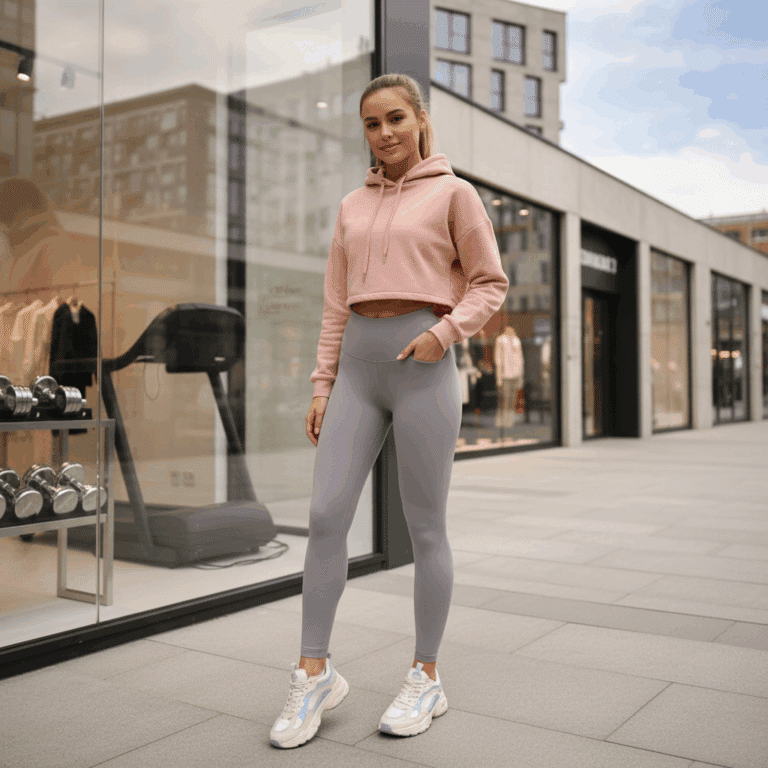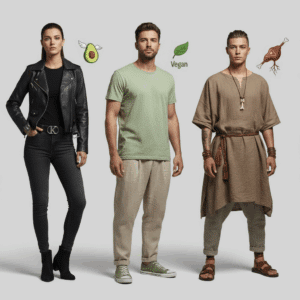Definition and Origins of Athleisure
Athleisure combines athletic apparel with leisurewear, creating a versatile style that blends comfort and fashion. This trend reshapes how we approach everyday clothing.
Born from a rising interest in health and changing lifestyle habits, athleisure has evolved into a global phenomenon, merging sporty functionality with casual urban style.
Its foundation lies in blending performance wear with casual outfits, allowing for clothing that suits various daily activities while reflecting a modern, active lifestyle.
Meaning and Concept of Athleisure
The term athleisure is a fusion of “athletic” and “leisure,” describing clothing designed for both exercise and casual wear outside the gym.
This concept emphasizes items like leggings, sneakers, and sweatshirts, which offer comfort, style, and adaptability to multiple settings.
Unlike traditional sportswear, athleisure prioritizes aesthetic appeal alongside practicality, making sporty clothing acceptable in social and professional environments.
Early Development and Cultural Background
Initially, sportswear was confined to physical activities, but changing societal norms expanded its use to everyday life and workplaces.
Trends in wellness, relaxed workplace dress codes, and remote work contributed to athleisure’s rise, blending functionality with social acceptance.
Cultural Shift Behind Athleisure
The move towards athleisure reflects broader cultural values, emphasizing health, comfort, and a balanced lifestyle, influencing fashion conventions globally.
Factors Driving Athleisure’s Popularity
The rise of athleisure is driven by evolving lifestyle priorities. Health-conscious consumers seek apparel that supports an active life while maintaining style and comfort.
Alongside wellness, changing social norms and workplace expectations have broadened where athletic-inspired clothing is acceptable, fueling athleisure’s mainstream growth.
Additionally, global events have reshaped daily routines, making versatile, comfortable clothing essential in many aspects of life.
Health and Wellness Trends
Growing interest in health and fitness promotes athleisure as an ideal choice. Consumers want clothes that encourage movement and well-being without compromising on fashion.
This trend reflects a global shift prioritizing active lifestyles, leading to demand for apparel that transitions seamlessly from workouts to casual or social settings.
The emphasis on mental and physical wellness encourages comfortable garments enhancing confidence and promoting everyday activity.
Workplace Dress Code Changes
Modern workplaces increasingly favor casual attire, breaking away from rigid formal dress codes. Athleisure fills this gap by offering neat yet comfortable options.
The rise of flexible work environments encourages clothing that supports productivity and comfort, making sporty garments acceptable even in semi-professional settings.
Corporate casual policies now embrace athleisure, reflecting a broader cultural acceptance of informal, functional fashion at work.
Impact of the COVID-19 Pandemic
The pandemic accelerated athleisure adoption due to remote work and stay-at-home measures, increasing demand for comfort-driven clothing suitable for all-day wear.
As people spent more time indoors, athleisure became a practical solution, blending leisure comfort with presentable style for virtual meetings and daily routines.
This shift solidified athleisure’s role in wardrobes worldwide, reshaping fashion priorities towards flexibility and ease without sacrificing aesthetics.
Market Impact and Industry Response
The athleisure market has seen exponential growth, becoming a dominant force in the global fashion industry. Its blend of style and comfort drives impressive economic influence worldwide.
Estimated to exceed $250 billion by 2026, the athleisure sector reflects massive consumer demand for versatile apparel that fits active, modern lifestyles.
This surge challenges traditional fashion norms, prompting industries to reinvent their approaches and capitalize on evolving consumer habits.
Growth and Economic Influence
Athleisure’s rapid growth is fueled by consumer preference for multifunctional clothing that performs well in diverse settings, from exercise to casual outings.
This trend contributes significantly to retail revenues, stimulating innovation and expanding market segments globally in both fashion and sportswear.
The economic impact extends to job creation, supply chains, and retail diversification, reshaping competitive strategies across apparel sectors.
Moreover, the pandemic amplified demand as comfort and practicality became essential, accelerating athleisure’s market penetration and consumer acceptance.
Adaptation by Fashion and Sports Brands
Traditional fashion labels have adapted by integrating athleisure into their lines, merging elegance with athletic-inspired comfort to retain relevance.
Sportswear giants like Nike and Adidas expanded beyond performance, focusing on luxury collaborations and stylish innovations to capture new audiences.
These brands invest in advanced fabrics enhancing breathability, flexibility, and aesthetic appeal, meeting consumer demands for both function and fashion.
Collaborations and Innovation
Collaborations between high-end designers and sports brands blend luxury with athleisure, exemplifying the industry’s dynamic response to changing trends.
Innovation in material technology drives the development of garments that offer superior comfort and sustainability, solidifying athleisure’s future in fashion.
Future of Athleisure in Fashion
The future of athleisure is closely tied to ongoing innovations in fabric technology that enhance comfort, durability, and functionality.
Additionally, evolving cultural values and lifestyle changes will continue to shape athleisure’s role, making it a permanent fixture in modern wardrobes.
This fusion of tech and culture ensures athleisure remains relevant, meeting demands for both performance and style.
Technological Innovations in Fabrics
Advances in textile engineering are revolutionizing athleisure, with fabrics now offering moisture-wicking, breathability, and stretch capabilities.
Smart textiles with embedded sensors are emerging, enabling clothing to monitor health metrics or adjust temperature according to the wearer’s needs.
Sustainability is also influencing fabric development, with eco-friendly materials gaining traction to meet environmental concerns within the athleisure market.
These innovations improve comfort and functionality, ensuring athleisure garments adapt to various activities and environments seamlessly.
Cultural and Lifestyle Influence
Athleisure reflects a cultural shift toward valuing wellness, balance, and versatility in both fashion and daily life.
As more people embrace active lifestyles and flexible work arrangements, athleisure’s casual yet stylish aesthetic aligns perfectly.
Influencers and social media play a key role in popularizing athleisure, reinforcing its image as a symbol of modern, effortless style.
Longevity of Athleisure
The integration of athleisure into mainstream fashion suggests it will continue evolving alongside societal trends.
Its blend of comfort, performance, and style addresses enduring consumer needs, securing a lasting presence in future fashion landscapes.






